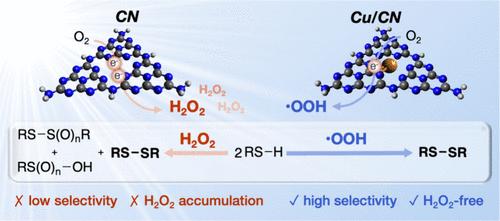Cu Anchored Carbon Nitride (Cu/CN) Catalyzes Selective Oxidation of Thiol by Controlling Reactive Oxygen Species Generation
IF 15.8
1区 材料科学
Q1 CHEMISTRY, MULTIDISCIPLINARY
引用次数: 0
Abstract
Production of H2O2 using heterogeneous semiconductor photocatalysts has emerged as an ecofriendly and practical approach across various applications, ranging from environmental detoxification to fuel cells and chemical synthesis. Extensive efforts have been devoted to engineering semiconductors to enhance their catalytic capabilities for H2O2 production. However, in chemical synthesis, the utilization of the potent oxidant H2O2 can present challenges in selectively oxidizing organic compounds. In this study, we introduce copper atoms into carbon nitride (Cu/CN), facilitating the generation of hydroperoxyl radicals (·OOH) as primary reactive oxidants and offering reaction conditions entirely devoid of H2O2 via the Fenton reaction. Cu/CN demonstrates selective oxidation of thiols to disulfides, in contrast to other current heterogeneous photocatalysts that yield undesired overoxidized side products, such as thiosulfinate and thiosulfonate. Cu/CN’s controllable capacity for specific ROS generation, broad substrate scopes, and recyclability empower greener and highly selective photooxidation of organic compounds.

氮化铜锚定碳(Cu/CN)通过控制活性氧生成催化硫醇的选择性氧化作用
利用异质半导体光催化剂生产 H2O2 已成为一种环保和实用的方法,其应用范围广泛,从环境解毒到燃料电池和化学合成。人们一直致力于对半导体进行工程设计,以增强其生产 H2O2 的催化能力。然而,在化学合成中,利用强效氧化剂 H2O2 选择性地氧化有机化合物是一项挑战。在本研究中,我们将铜原子引入氮化碳(Cu/CN),促进氢过氧自由基(-OOH)作为主要活性氧化剂的生成,并通过芬顿反应提供完全没有 H2O2 的反应条件。Cu/CN 可将硫醇选择性地氧化为二硫化物,而目前的其他异相光催化剂则会产生不受欢迎的过氧化副产品,如硫代亚硫酸盐和硫代磺酸盐。Cu/CN 对特定 ROS 生成的可控能力、广泛的底物范围和可回收性使其能够对有机化合物进行更环保和高选择性的光氧化。
本文章由计算机程序翻译,如有差异,请以英文原文为准。
求助全文
约1分钟内获得全文
求助全文
来源期刊

ACS Nano
工程技术-材料科学:综合
CiteScore
26.00
自引率
4.10%
发文量
1627
审稿时长
1.7 months
期刊介绍:
ACS Nano, published monthly, serves as an international forum for comprehensive articles on nanoscience and nanotechnology research at the intersections of chemistry, biology, materials science, physics, and engineering. The journal fosters communication among scientists in these communities, facilitating collaboration, new research opportunities, and advancements through discoveries. ACS Nano covers synthesis, assembly, characterization, theory, and simulation of nanostructures, nanobiotechnology, nanofabrication, methods and tools for nanoscience and nanotechnology, and self- and directed-assembly. Alongside original research articles, it offers thorough reviews, perspectives on cutting-edge research, and discussions envisioning the future of nanoscience and nanotechnology.
 求助内容:
求助内容: 应助结果提醒方式:
应助结果提醒方式:


